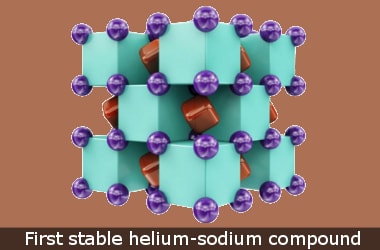
Helium is the second most abundant element in the Universe
It belongs to a six-member group of elements called the noble gases.
These are so-called because of an apparent 'aloofness' that prevents them from easily forming compounds with other elements.
Since earning their 'noble' reputation, some of these gases have shown signs of reactiveness under extreme conditions.
One can actually split the noble gases up into two groups, with krypton, xenon, and radon considered to be relatively reactive, and argon, neon, and helium considered to be very unreactive.
Researchers have found ways to pair up helium with other elements in the past, but until now, the result has always been less than concrete.
One of the most common examples of helium interacting with other elements refers to van der Waals forces - attractive or repulsive forces that don't require conventional covalent or ionic bonds to form.
It's known that very weak van der Waals forces exist between helium and other atom.
At extremely low temperatures, helium can form van der Waals molecules - very weakly bound clusters of atoms or molecules - but they cannot be sustained for long.
Helium's staunch stability is due to its closed-shell electronic configuration - its outer shell is complete, which means there's no room for it to bond with other atoms by sharing electrons.
Being one of the most abundant elements in the Universe, responsible for forming stars and gas giant planets, helium could play by very different rules out in space and deep within our planet.
The researchers have just found the first evidence yet of that weird behaviour.
The researchers used a 'crystal structure-predicting' computer model to predict that under extreme pressures, a stable helium-sodium compound could form.
They then physically created the never-before-seen compound, Na
2He, in a diamond anvil cell experiment.
This allowed them to subject helium and sodium atoms to pressures of around 1.1 million times Earth's atmospheric pressure.
"These findings were so unexpected, scientists and their colleagues struggled for more than two years to convince science reviewers and editors to publish their results.
Based on this, sodium will easily bond with helium gas to form a stable Na
2He compound under pressures up to 10 million times higher than the level they achieved it at.
The compound appears to form without any chemical bonds to hold it together.
Helium atoms do not actually form any chemical bonds, yet their presence fundamentally changes chemical interactions between sodium atoms, forces electrons to localise inside cubic voids of the structure, and makes this material insulating.
Here's the crystal structure of Na
2He - a solid formation of alternating sodium and helium atoms, with electrons shared in the voids between them.
Chemists have made a number of these 'rule-breaking' discoveries recently, with separate teams creating the world's first sample of metallic hydrogen, and a carbon molecule with six - not four - bonds last month.
This helium compound is a breakthrough.
Helium: Know More- Symbol: He
- Atomic mass: 4.002602 u ± 0.000002 u
- Atomic number: 2
- Electron configuration: 1s2
- Discovered: 1868
- Melting point: -272.2°C
- Discoverers: Pierre Janssen, Norman Lockyer